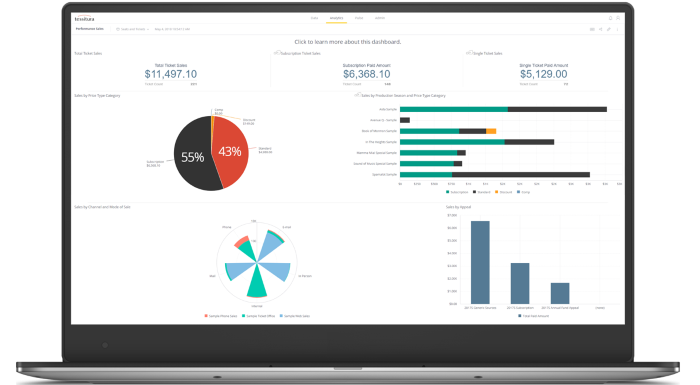Arts and Culture
Article
Insights & Innovation
1ad86644-ab7e-4d7d-8059-5c2eccd79061
5 min
https://edge.sitecorecloud.io/tessituraneab9a-tessiturane5642-staging-5396/media/Images/Discover-Images/Thought-Leadership/Analytics-User-768x465.png?h=465&iar=0&w=768
The CEO of Sisense on gut feelings, thinking in multiple dimensions, and innovating for a better world
What arts & culture can learn from a data analytics visionary

President & CEO, Tessitura
What arts & culture can learn from a data analytics visionary
6/1/2022
5 min
“Today, every business must be data driven or risk obsolescence.”
I recently spoke with Amir Orad, CEO of Sisense, one of the world’s top data analytics companies. Sisense is the technology behind Tessitura Analytics, our embedded analytics suite.
I began by congratulating Amir on the news that Sisense has recently edged out Salesforce/Tableau on the Visionary axis of the Gartner Magic Quadrant for Analytics and Business Intelligence Platforms. In addition to Tessitura, Sisense powers data analytics for NASDAQ, Air Canada, Verizon, and GE, among many others.
Typically, we chat about partnership topics, but for this discussion, I had a different goal in mind. I opened with a simple question: What can the arts and culture sector learn from the leader of a data analytics Visionary?

Amir Orad, CEO of Sisense with Andrew Recinos, President & CEO of Tessitura, at a recent meeting in Sisense’s New York City headquarters
Tip 1: Make decisions with current data, not intuition
In the past, leaders would often make decisions based on intuition and gut feel, and perhaps that was good enough. Not any more, according to Amir. In a world with this much change, “gut feelings are irrelevant right now. We can’t look to the past to make decisions. We have to retrain our brains for what is happening right now. Data in real time is critical.”
For arts & culture organizations, that means drilling deep into daily sales, current membership renewal rates and timing of purchases. Yearly trends used to be useful. These days, monthly or even weekly trends may provide better insights.
“Today, every business must be data driven or risk obsolescence.”
Tip 2: Our brains think in three dimensions. Data analytics help us think in 20
How can arts & culture organizations get the most wisdom from their present-day data? Amir has a new way to think about this. “The human brain can only think in three or four dimensions at a time. With an analytics tool you can consider data from 20 or more dimensions.” (In the data analytics world, “dimension” refers to a distinct set of attributes that can be analyzed.)
Consider your ticket sales or admissions in the past month. To make decisions, we typically look at the same few dimensions: When did they attend? What price points are most popular? Did they purchase via the web or another channel?
Now consider all the other dimensions data analytics can provide: How far in advance was their purchase? What else did they purchase at the same time? What promotion inspired their purchase? Where do they live? Who isn’t returning?
With each additional dimension, you get a more complete picture to inform real-time decisions.

Tessitura Analytics is powered by Sisense with dashboards and measures purpose built for arts and culture business cases.
Tip 3: Arts & culture could use a little AI
Artificial Intelligence (AI) is now helping many industries thrive. As one example, Amir explained how Amazon uses AI to stock their local warehouses with products they suspect you will be ordering before you order them.
Now imagine if you could accurately predict attendance, ticket sales, or donation effectiveness — Amazon-style — in advance of the outcome. The first step is on its way. Sisense embeds AI throughout its analytics technology, and with Tessitura Version 16, arriving this month, Tessitura Analytics will include a powerful AI-driven forecasting tool.

In Tessitura v16, you can now apply Sisense’s AI-based forecasting to sales, donation and membership trends.
To summarize the first three tips:
Narrow your focus to current data (Tip 1),
Broaden your focus to many dimensions of data (Tip 2), and
Deploy AI (Tip 3) to fill in what’s missing, all in service of helping your organization thrive.
Which brings us to Tip 4:
Tip 4: Data analytics can help make the world a better place
Amir shared that by partnering with Tessitura, he and his team get a huge thrill from knowing that they are helping the arts and culture sector thrive. “In the past, arts and culture has trailed other industries in terms of analytics, and yet what you all do is critical to so many lives. We are glad to play a small part in moving your industry forward.”
In closing, Amir told me: “Today, every business must be data driven or risk obsolescence.” In a time of such uncertainty in the arts & culture industry, we must use the best technologies at our disposal to be data informed.
In partnership with Sisense, Tessitura is helping our members harness their data to improve their operations, connect with their community, and ultimately make the world a better place.
Topics
Arts & Culture

Why Arts & Culture is Essential Today
Arts & Culture
Healing the world requires five human traits: arts & culture delivers them all.

A contactless customer journey with a personal touch
Arts & Culture / Business Strategy / COVID-19 / Technology / Ticketing & Admissions
How Georgia Aquarium creates a visitor-focused experience
